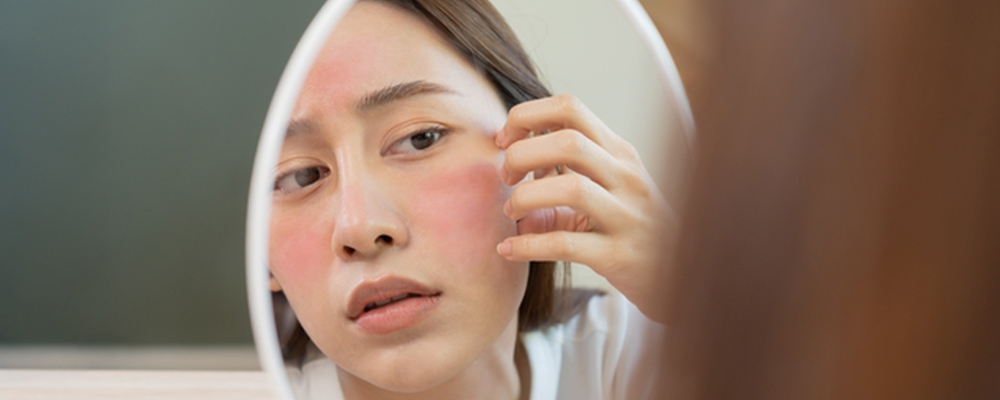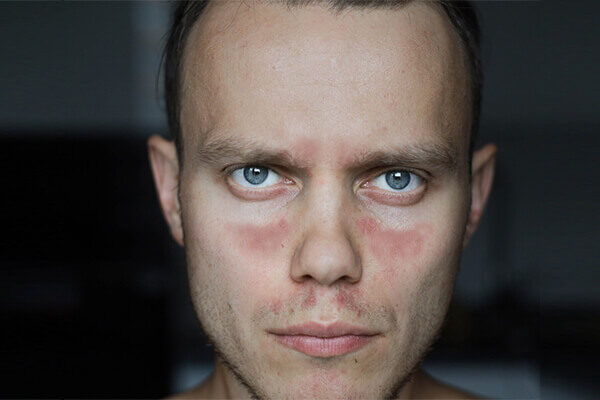Updated on May 8, 2023
Introduction
Rosacea fulminans, also known as pyoderma faciale, is a severe and uncommon form of rosacea that primarily affects women in their early 20s to 30s. It is characterized by sudden and rapid onset of painful, red, and inflamed nodules and pustules on the face.
This condition typically occurs in people with a history of mild to moderate rosacea. However, the exact cause of this condition is not yet fully understood. it may be triggered by hormonal factors, such as changes in estrogen levels, while others suggest that it may be related to an abnormal immune response.
It is important to note that rosacea fulminans can cause scarring and may have a significant impact on a person’s quality of life. Therefore, it is important to seek prompt medical attention if one suspects one may be experiencing this condition.
Also, visit: Papulopustular Rosacea Study
What is Rosacea Fulminans?
Rosacea fulminans is a very uncommon form of inflammatory skin disease that primarily affects the convex and central parts of the face, such as the nose, chin, zygomatic region, and forehead. It fluctuates between the remission and exacerbation phases. It is characterized by the sudden appearance of erythematous papules, pustules, nodules, and draining sinuses on the face all of a sudden. There are no systemic symptoms of pyoderma faciale. The majority of patients had rosacea in the past.
Although the underlying pathophysiology of this condition is not clear, it is believed to be multifactorial and involves vascular, hormonal, and immunologic factors. Most often, it affects women in their 20s and 30s.
What are the Causes of Rosacea Fulminans?
Although its etiology is still unknown, rosacea fulminans has multiple causes. Numerous vascular, hormonal, and immunologic factors have been suggested as triggers. Flushing is brought on by drinking alcohol and eating hot, spicy food, and in some patients, this can make their rosacea worse or even start it.
This may be partially brought on by hormonal factors in pregnant women and women using oral contraceptives. Drug use, seborrhea, and emotional stress are additional triggering factors.
What are the Symptoms of Rosacea Fulminans?
It is characterized by the sudden onset of severe inflammation and pustules on the face, often accompanied by fever and joint pain. Some of the common symptoms of rosacea fulminans include:
- Sudden onset of severe redness and inflammation on the face, often accompanied by papules and pustules.
- Swelling of the face and eyelids.
- Burning or stinging sensation in the affected areas.
- Flushing and blushing of the skin.
- Painful nodules or cysts on the face.
- Ocular symptoms, such as dryness, burning, itching, and sensitivity to light.
- Fatigue and fever may also occur in some cases.
It is important to note that the symptoms of rosacea fulminans can be severe and can cause significant emotional distress.
What are the Complications of Rosacea Fulminans?
If left untreated, it can lead to several complications. Some of the potential complications include:
- Scarring: Severe inflammation of the skin can lead to scarring, which can be permanent and difficult to treat.
- Emotional distress: The psychological impact of severe facial skin inflammation can be significant, leading to anxiety and depression.
- Ocular complications: Rosacea can affect the eyes, causing a condition known as ocular rosacea. This can cause dryness, irritation, and inflammation of the eyes.
- Infections: The broken skin caused by severe rosacea can become infected, leading to further complications.
- Secondary infections: The use of immunosuppressive therapy may lead to secondary infections, particularly from opportunistic microorganisms.
Rosacea Fulminans: Diagnosis and Treatment
Diagnosis:
The diagnosis of rosacea fulminans (RF) is usually made by a dermatologist or a skin specialist. The diagnosis is based on a combination of clinical presentation, medical history, and laboratory tests to exclude other potential causes of facial inflammation.
During the diagnosis, the dermatologist will typically perform a thorough physical examination of the skin and take a detailed medical history, including a review of any medications or topical agents used on the face. The dermatologist may also perform laboratory tests, such as blood tests or a skin biopsy, to rule out other conditions with similar symptoms.
The diagnosis of rosacea fulminans is made based on the presence of sudden-onset severe facial redness, inflammation, and the presence of papules, pustules, nodules, or cysts. RF is usually differentiated from other types of rosacea by its more severe symptoms and rapid onset.
Treatment:
Treatment for this condition typically involves a combination of medications and lifestyle changes.
-
Oral medications:
The first line of treatment for rosacea fulminans typically involves oral antibiotics such as tetracycline, doxycycline, or minocycline. These antibiotics work by reducing inflammation and killing the bacteria that contribute to the condition.
-
Topical medications:
In addition to oral antibiotics, your doctor may also prescribe topical medications such as metronidazole or azelaic acid. These medications are applied directly to the affected areas of the skin and work by reducing inflammation and redness.
-
Isotretinoin:
In cases where oral and topical medications are not effective, isotretinoin may be prescribed. This medication is a powerful acne medication that can also be used to treat severe cases of rosacea.
-
Lifestyle changes:
Making healthy lifestyle changes can also help manage rosacea fulminans. This includes avoiding triggers such as alcohol, spicy foods, and stress. It is also important to use gentle skincare products and avoid using harsh chemicals on the skin.
-
Laser therapy:
Laser therapy may be recommended in some cases to help reduce the redness and inflammation associated with the condition.
It is important to work with a doctor to find the right treatment plan for one’s individual needs. With proper treatment, rosacea fulminans can be effectively managed.
Also read: Lupus Rash vs Rosacea
Outlook
Rosacea fulminans, also known as pyoderma faciale, is a severe form of rosacea that primarily affects women in their 20s to 30s. It is characterized by the sudden onset of deep, painful nodules and pustules on the face, which can result in significant scarring and disfigurement.
Early and proper treatment, particularly with oral isotretinoin and an oral corticosteroid, is critical to achieving good short- and long-term results. All of this is geared towards avoiding scarring, which can be persistent, deforming, and stigmatizing, lowering one’s self-esteem.





